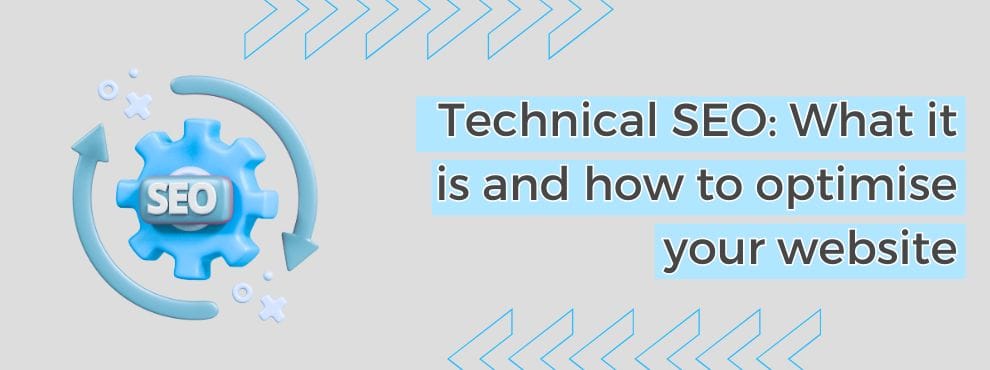In the vast universe of digital marketing, SEO (Search Engine Optimization) has become an essential discipline to ensure the visibility of a website on search engines. However, within this field, there is a branch that is often ignored or little understood, despite its crucial importance: technical SEO. In this article, from IDX Innovadeluxe, specialists in digital marketing and online store creation, we explain in detail what technical SEO is, why it is important and how you can optimize your website to improve its performance and positioning.
Table of contents
what is technical SEO?
Technical SEO refers to the set of optimizations made to the structure and code of a website in order to facilitate crawling, indexing and understanding by search engines. Unlike on-page SEO (focused on content and keywords) or off-page SEO (focused on external links), technical SEO acts as the foundation that allows everything else to work properly.
This type of SEO focuses on aspects such as loading speed, web architecture, URL structure, implementation of structured data, mobile compatibility, among other factors that, although invisible to the eye of the average user, are fundamental for search engines.
Importance of technical SEO for your website
A website with technical problems can significantly hinder your search engine rankings. Google and other engines highly value user experience, and this starts with a fast, accessible, easy to crawl and secure site.
Imagine an online store that takes too long to load or does not adapt to mobile devices. Even if the content is excellent, users abandon quickly and Google perceives this as a bad experience, penalizing the site in its results. Technical SEO prevents this type of inconvenience and allows the rest of the optimization work to shine.
Loading speed and web performance
The loading speed of a site is one of the most influential factors in technical SEO. Google has confirmed that speed is a ranking signal, and furthermore, it directly influences bounce rate. A slow site frustrates users and drives them to look for alternatives.
Optimizing speed involves working on several fronts: compressing images without losing quality, using modern formats such as WebP, minimizing CSS and JavaScript files, enabling GZIP compression, taking advantage of caching and choosing a good hosting provider. It is also advisable to use tools such as Google PageSpeed Insights or Lighthouse to identify bottlenecks and get specific suggestions.
Site architecture and URL structure
A well-designed web architecture makes navigation easier for both users and search engine robots. Ideally, all important pages should be no more than three clicks away from the home page. This translates into a hierarchically organized site, with well-defined categories and subcategories.
URL structure also plays an important role. Clean, short, descriptive URLs are easy for users and search engines to understand. For example, a URL such as http://www.tutienda.com/zapatos-hombre/deportivos is much more effective than www.tutienda.com/producto?id=1234. In addition, duplicate content should be avoided and 301 redirects should be used properly when changing the site structure.
Indexing and crawling
Google needs to be able to crawl and index your site in order to display it in search results. The robots.txt file and the XML sitemap are two fundamental tools to control this process.
The robots.txt file tells the engines which parts of the site to avoid, which helps conserve the crawl budget. On the other hand, the XML sitemap provides a clear list of all the important URLs that should be indexed. It is important to keep this file updated and submit it to Google Search Console.
Additionally, it is key to avoid frequent 404 errors, make sure that there are no unnecessary blocks by the robots.txt file, and check HTTP status codes to ensure that pages are working properly.
Structured data and rich snippets
Structured data are snippets of code that allow search engines to better understand the content of a page. Using schemas such as Schema.org, you can mark relevant information such as products, reviews, prices or events, which increases the chances of your site appearing with rich snippets in search results.
These snippets not only improve your site’s appearance in Google, but also increase click-through rates by standing out visually. Properly integrating structured data requires technical expertise, but the visibility benefits can be remarkable.
Mobile compatibility and user experience
With the implementation of mobile-first indexing, Google prioritizes the mobile version of a website when ranking it. Therefore, it is essential that your site is fully responsive and offers a smooth user experience on any device.
This implies designing with small screens in mind, optimizing loading times on mobile networks, avoiding intrusive elements such as aggressive pop-ups and ensuring that all buttons and menus are easy to use by touch. A poor mobile experience translates into immediate abandonment and, therefore, poor rankings.
Site security: HTTPS as standard
Security is also part of technical SEO. Google considers the use of HTTPS as a ranking factor and, moreover, modern browsers mark any site that does not use this protocol as “not secure”.
Installing an SSL certificate not only improves your ranking, but also builds trust with users, especially if you manage personal data or perform transactions. Nowadays, many hosting companies offer free certificates that you can activate with just a few clicks.
Conclusion
Technical SEO is like the foundation of a house: you can’t see it, but it supports the whole structure. Without a solid foundation, any effort in content or links is weakened. From IDX Innovadeluxe we recommend you to periodically audit your site, identify technical bottlenecks and apply continuous improvements.
Remember that the digital world is competitive and constantly evolving. Keeping your website optimized from a technical point of view is not only a recommended strategy, but a necessity to stand out from the competition and provide the best possible experience to your users.




Deja un comentario